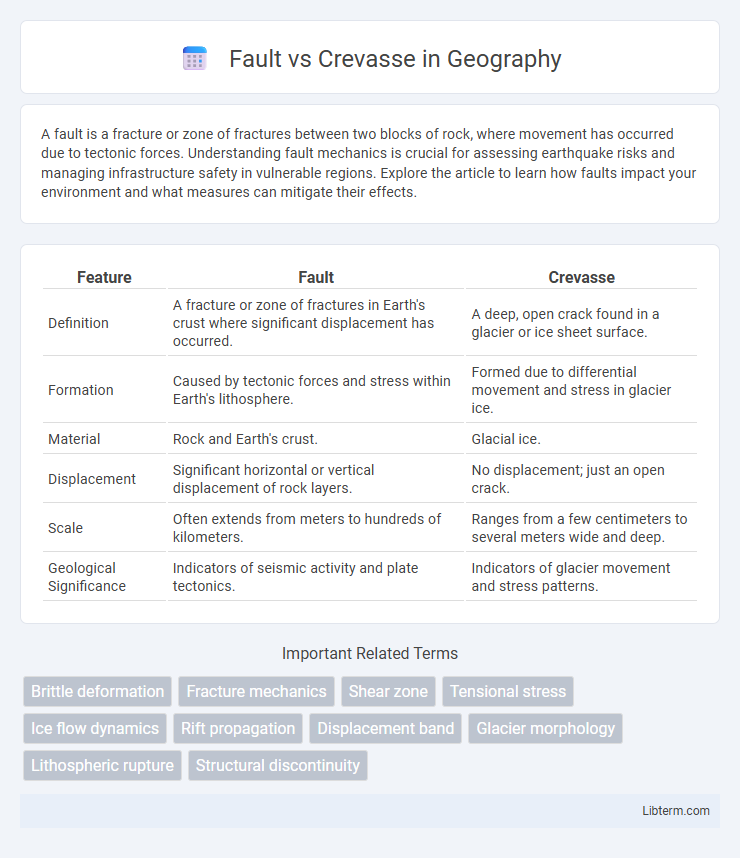A fault is a fracture or zone of fractures between two blocks of rock, where movement has occurred due to tectonic forces. Understanding fault mechanics is crucial for assessing earthquake risks and managing infrastructure safety in vulnerable regions. Explore the article to learn how faults impact your environment and what measures can mitigate their effects.
Table of Comparison
| Feature | Fault | Crevasse |
|---|---|---|
| Definition | A fracture or zone of fractures in Earth's crust where significant displacement has occurred. | A deep, open crack found in a glacier or ice sheet surface. |
| Formation | Caused by tectonic forces and stress within Earth's lithosphere. | Formed due to differential movement and stress in glacier ice. |
| Material | Rock and Earth's crust. | Glacial ice. |
| Displacement | Significant horizontal or vertical displacement of rock layers. | No displacement; just an open crack. |
| Scale | Often extends from meters to hundreds of kilometers. | Ranges from a few centimeters to several meters wide and deep. |
| Geological Significance | Indicators of seismic activity and plate tectonics. | Indicators of glacier movement and stress patterns. |
Definition of Faults
Faults are fractures in the Earth's crust where significant displacement has occurred due to tectonic forces, resulting in the movement of rock masses along the fracture plane. These geological structures are characterized by their ability to offset rock layers, which can cause earthquakes and influence landscape formation. Unlike crevasses, faults can extend deep into the crust and affect large regions, playing a crucial role in plate tectonics and seismic activity.
Definition of Crevasses
Crevasses are deep, open fractures in glacier ice caused by differential movement and stress, often forming perpendicular to the glacier flow. Unlike faults, which are fractures in the Earth's crust where blocks of rock move relative to each other, crevasses primarily occur in ice and result from tensile stress exceeding the tensile strength of the glacier. These features can vary in width and depth, sometimes extending tens of meters, posing significant hazards in glaciated terrains.
Geological Processes Behind Faults
Faults form from tectonic forces causing fractures and displacement in Earth's crust, resulting in significant rock movement along the fault plane. These geological processes involve stress accumulation and release due to plate tectonics, such as compression, tension, or shear stress. Crevasses, on the other hand, are surface cracks primarily found in glaciers, caused by ice deformation rather than tectonic activity.
Formation of Crevasses in Glacial Ice
Crevasses form in glacial ice due to differential stress caused by the glacier's movement over uneven terrain, resulting in tension that exceeds the ice's brittle strength. These fractures develop perpendicular to the direction of the glacier's flow where the ice stretches and thins, commonly near steep slopes or bends. Unlike faults, which are fractures in Earth's crust involving displacement of rock masses, crevasses are surface cracks confined to the brittle upper layer of the glacier ice.
Key Differences Between Faults and Crevasses
Faults are fractures in the Earth's crust where significant displacement has occurred due to tectonic forces, often extending deep into the lithosphere, while crevasses are shallow, surface cracks primarily found in glacier ice formed by stress and movement within the ice. Faults can cause earthquakes and usually span kilometers, whereas crevasses measure meters to tens of meters in length and pose hazards mainly to glaciologists and mountaineers. The key difference lies in their formation context and scale: faults are geological boundaries between tectonic plates or blocks, while crevasses are structural features of moving ice masses.
Types of Faults
Faults are fractures in the Earth's crust along which movement has occurred, classified primarily into three types: normal, reverse (or thrust), and strike-slip faults. Normal faults form due to extensional forces causing the hanging wall to move downward relative to the footwall, common in divergent boundaries. Reverse faults, resulting from compressional forces, push the hanging wall up, often found in convergent boundaries, while strike-slip faults involve lateral horizontal movement, typical of transform boundaries.
Types of Crevasses
Crevasses are deep, open cracks in glacier ice formed mainly due to tensile stress from differential ice movement, categorized into longitudinal, transverse, and splaying crevasses based on their orientation relative to the glacier flow. Longitudinal crevasses run parallel to the glacier flow, often appearing in areas where the glacier is widening, while transverse crevasses form perpendicular to flow and typically occur where the glacier is subjected to extensional stress. Splaying crevasses radiate outward from the glacier edges and are common where the ice spreads laterally or encounters obstacles, distinguishing them from faults, which are fractures in rock with displacement across the fracture plane.
Environmental Impacts of Faults and Crevasses
Faults disrupt subsurface geology, often triggering earthquakes that cause soil liquefaction, landslides, and infrastructure damage, significantly impacting ecosystems and human settlements. Crevasses, typically forming in glaciers, accelerate ice melt and contribute to glacial retreat, influencing sea-level rise and freshwater availability. Both features alter natural landscapes but differ in scale and type of environmental disturbances, with faults primarily affecting tectonic stability and crevasses impacting cryospheric dynamics.
Faults and Crevasses in Natural Disasters
Faults are fractures in Earth's crust where tectonic plates move, often causing earthquakes and resulting in significant ground displacement and damage during natural disasters. Crevasses are deep, narrow cracks that form in glaciers due to stress and movement, posing hazards in glacial environments but not typically triggering seismic events. Understanding faults is crucial for earthquake risk assessment, while monitoring crevasses aids in glacier safety and predicting ice dynamics.
Detection and Monitoring Technologies
Fault detection relies on seismic imaging and GPS measurements to monitor earth crust movements and stress accumulation, providing early warning of potential earthquakes. Crevasse monitoring uses ground-penetrating radar (GPR) and aerial drones equipped with LiDAR sensors to map surface fractures and changes in glacier ice structure. Satellite-based InSAR technology enhances both fault and crevasse detection by capturing minute surface deformations over time.
Fault Infographic

 libterm.com
libterm.com